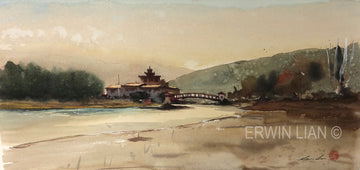Most artists know watercolor is a temperamental medium.
What many artists don’t know are just how many watercolor techniques simply don’t work on subpar materials.
Pigment, brushes, paper, technique - all of them depend on one another to be their best selves. You could buy the best pigment EVER… and then your crummy paper disintegrates under the first wash.
Think about it - there are tricks and techniques out there that might change the way you paint forever…
...that are just physically impossible if you use low quality materials.
So - where do we start? And what does “quality” even mean?
First, we have to break down what kind of paper works for which technique, and why.
(If you have a special technique you want to learn, keep reading to see how you might get a primer on it from one of the best watercolorists in the world!)
Today, I share a conversation I had with Erwin Lian, creator of The Perfect Sketchbook. Erwin hosted 2 successful crowdfunding campaigns and then partnered up with us in order to keep the best watercolor sketchbooks going.
In short - if someone knows their stuff about watercolor paper, pigments and all the necessary watercolor supplies, it’s Erwin. ;)
Join us today as we discuss:
- Student Vs Artist Grade Materials.
- The anatomy of good watercolor paper.
- When (and why) skills aren’t everything.

How does Student Grade differ from Artist Grade supplies?
Specialty art stores are great because they offer a wealth of supplies in every option there is.
An astounding, exhilarating, absolutely terrifying and overwhelming assortment of supplies, that is impossible to navigate if you don’t know what you’re looking for.
A common distinction is that of “Student Grade” and “Artist Grade.” You might find “Student Grade” watercolor sets that cost $15, and “Artist Grade” sets that go way above $80. So, what’s the big difference?
Generally, Student Grade materials run cheaper, provide lower performance, and are made for folks just starting out (who don’t need their work to look the best it can.) Artist Grade runs higher quality in most aspects.
Student Grade materials are useful for quantity of work over quality, so manufacturers generally cut corners in a few different aspects:
- In Paint:
- Pigment concentration
- Physical properties (dilution, mixing, flowing)
- Longevity of colors
- Variety of colors
- In Paper:
- Cotton content
- Grain Flow
- Strength & Pliability
- Absorbency
Erwin explains:
In other words, Student Grade supplies are great for people starting to explore the medium, since they’re cheaper. However…
…don’t get frustrated when the results are not what you expect. Student Grade supplies don’t last very long.
Quality isn’t cheap, but in the long run it pays off (just like my favorite, expensive sweater that I have for years and is still in pristine condition… versus the cheap one that I had to throw away after a couple of washes.)

What does cotton content do?
There is a bit of variety when it comes to the materials found in watercolor paper:
- Wood Pulp:
- Less expensive papers are made using wood pulp, or a combination of cotton and other cellulose fibers (Student Grade).
- Cotton:
- The best quality paper (Artist Grade) is 100% cotton (which, because of the cost, is not as common).
Why is 100% cotton paper better? Because it is made from linters - long cotton fibers!
The length of these fibers is a lot longer than wood fiber and this makes cotton paper a lot stronger and more durable. It also absorbs water much better than other materials.
Cotton paper is archival grade and acid free, which means that it will not deteriorate over time.
...and how does that affect the techniques you can use?
Well, if you’re planning on using lots of scraping, taping, scrubbing and masking techniques, then 100% cotton is the paper you’re looking for. (Try that with wood pulp paper and watch it fall apart in front of your eyes.)

Not all cotton is created equal
Now, is there a difference when picking between different 100% cotton watercolor paper?
Erwin thinks the difference is “Sizing.”:
Aaaaaand this is why we had Erwin try all the 100% cotton paper we considered for our Sketchbook Range. You can bet we picked the best!
...oh, and did we mention that the gelatin used when sizing our paper as well as the glue to bind our books is vegan friendly? ;)
The myth about paper weight
Personal rant time:
I see a lot of artists comparing paper weight as if it were indicative of quality. It’s actually not.
Sure, 300g paper prevents buckling better than a 200g one, but what if we’re comparing wood pulp paper to cotton?
Here’s Erwin’s thoughts:
Apples and oranges, guys. Don’t believe me? Grab a 200g wood pulp paper and a 200g cotton paper and see what holds water and pigment better!
...apples and oranges.
[ right click on the image below - 'view image' to see a bigger version ]

What's your watercolor technique wishlist?
So we’ve gone into the details of what differs in artist materials, and why.
In part 2 of this series, I’ll share some of Erwin’s favorite advanced techniques for high end materials. But we haven’t settled on which techniques to tell you about (there are so many!)
So, I have a question for you…
If you could have Erwin Lian teach you ANY watercolor technique… what would it be?
Put your techniques wishlist in the comments, and we might cover them in the next blog post!
- Ânia, Branding & Marketing Manager for Etchr Lab who also paints <3



